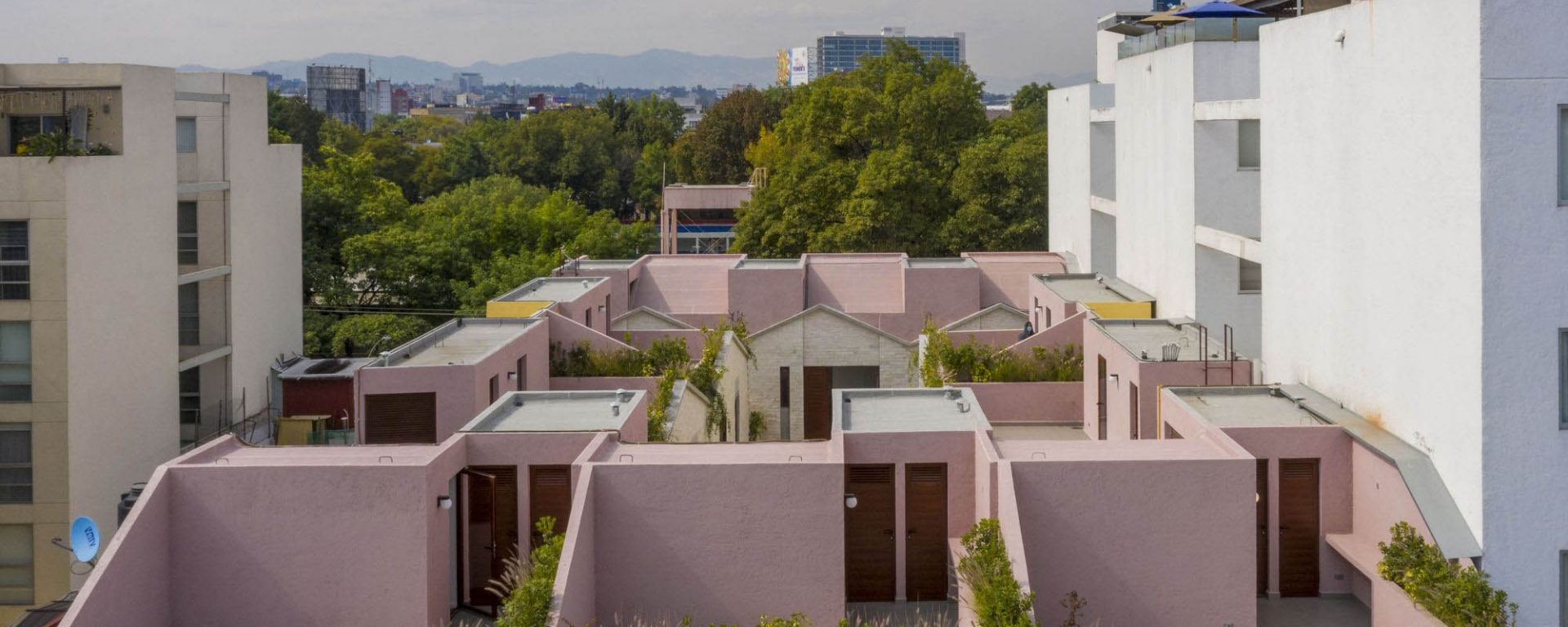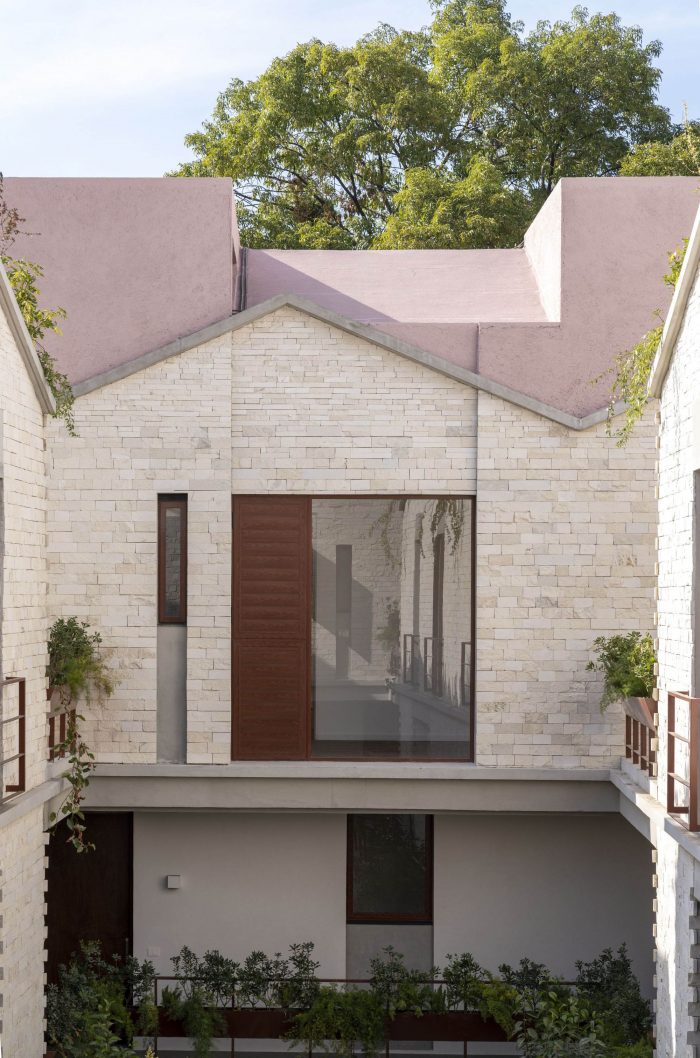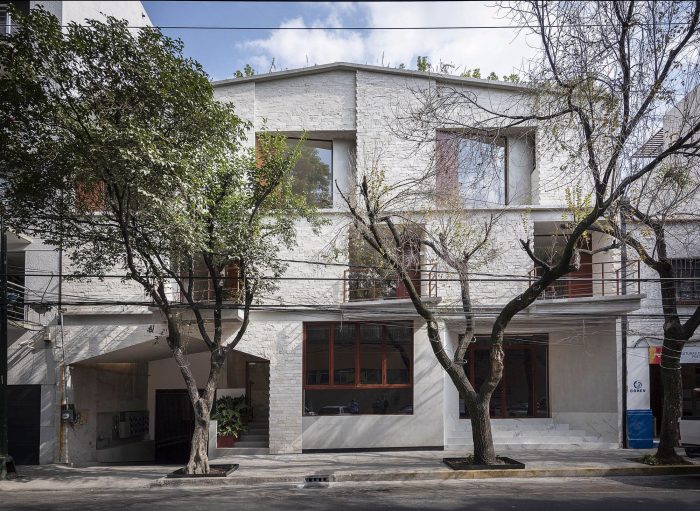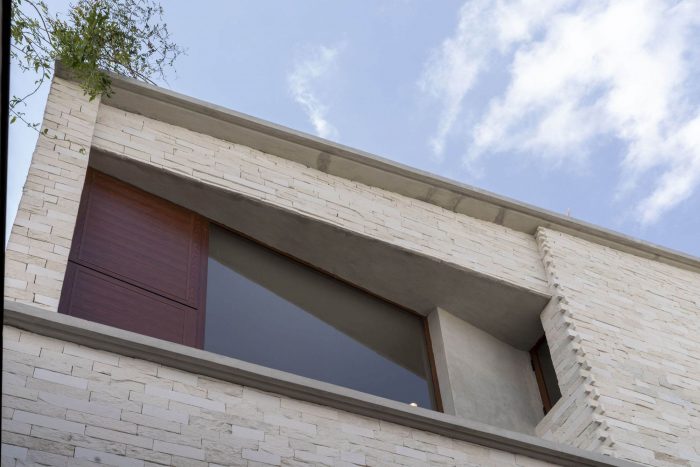“CASA JARDIN ESCANDÓN “位于墨西哥城Escandón社区的Agricultura街19号,该住房开发项目是一个带有街面商业的混合用途建筑。埃斯坎东社区在过去几年中蓬勃发展,具有新鲜和年轻的气息,艺术装饰建筑与新的现代建筑并存。
“CASA JARDIN ESCANDÓN” located at 19 Agricultura Street in the Escandón neighborhood of Mexico City, the housing development is a mixed-use complex with Street level commerce. The Escandón neighborhood with a recent boom in past years, with that fresh and youthful vibe, where art deco buildings coexist with new contemporary buildings.
CPDA将该项目设计为面向综合体内部,一个狭长但美味青翠的内院被塞进了综合体的脊柱中,在整个建筑中培养了一种宁静而友好的感觉。将自然光和交叉通风带入14个家庭中,紧凑的空间被一条 “之 “字形的路径导航,为一对底层公寓提供了三角形的阳台。
CPDA designed the project to live towards the interior of the complex a narrow but deliciously verdant inner courtyard is tucked into the spine complex, fostering a tranquil yet sociable feeling through the building. Bringing natural light and cross-ventilation into each of the 14 homes, the compact space is navigated by a zig-zagging path that accommodates triangular balconies for a pair of ground floor apartments.
覆盖在加拉扎石上的体量恰恰具有识别该地区的传统灵感。坡屋顶的外墙面向街道,混凝土板很突出,这反过来又在第一层突出了它的排列,以产生阳台,允许在住宅内部的社交区域与外部有更自由的关系。另一方面,朝向中央庭院的室内立面有不同的语言,在那里产生了不同的窗户、开口和坡屋顶的游戏,以创造一个简单、动态、有趣和巧妙的复杂形式。
浅色的Galarza砖为院子里丰富的绿色植物提供了一个清晰而有触感的背景,而窗户和栏杆上的大地色系则加强了一个接地气的舒缓氛围。在一个小院子里,浅色调和微妙的砖块衔接的不挑剔组合也使空间更加舒适。
The volume covered in Galarza Stone has exactly that traditional inspiration that identifies the neighborhood. With a gabled facade facing the Street where the concrete slabs stand out, which in turn on the first level stand out from its alignment to generate balconies to allow a freer relationship with the outside in the social areas of the residential interior. On the other hand, the interior facades towards the central courtyard have a different language, where a game of different windows, openings and gabled roofs are generated, to create a simple, dynamic, fun and ingenious form of the complex.
The light Galarza bricks offer a crisp yet tactile backdrop for the courtyard´s rich greenery, while earth tones on the windows and railings reinforce a grounded, soothing ambiance. In a small courtyard, the unfussy combination of light tones and subtle brick articulation also make for a more comfortable space.
四个套房–每个都有一个私人绿地–占据了底层,上面有10个较大的三层公寓。为了满足家庭的需求,上层的联排别墅式住宅都有一个私人屋顶花园。在定义建筑临街面的砖包形式之上,最上层将室外绿色空间与离散的粉红色住宅体量结合在一起,远离庭院。从上面看,它是当地绿树成荫的天际线上的一个优雅的点缀。
Four suites – each with a private green space – occupy the ground floor, with 10 larger three-storey apartments above. Catering to families, the townhouse-style homes on the upper levels each feature a private rooftop garden. Atop the brick-clad form that defines the building´s street level presence, the uppermost storey combines outdoor green space with discrete dusty pink residential volumes set back from the courtyard. From above, it´s a graceful accent on the tree-lined local skyline.
该项目的中央庭院种植了各种本地植物和耐阳光的物种,它们对当地气候的熟悉程度使其在未来不需要大量的维护。一个邀请你反思和沉思中央花园及其不同种类的植物和花卉的空间。这个内部花园是设计方案中最重要的元素,我们在这里寻找一种神奇的存在,建筑在这里创造了永久和沉思的空间。仔细考虑面向中央庭院的阳台的距离、方向和安排,其结果是居民和他们共同的 “秘密花园 “之间的谨慎、私人和和平的互动。
The central courtyard of the project houses a variety of native plants and species tolerant to sunlight, whose familiarity with the local climate negates the need for much maintenance in the future. A space that invites you to reflect and contemplate the central garden and its different species of plants and flowers. This interior garden is the most important element of the design proposal, where we look for a magical presence where architecture creates the space for permanence and contemplation. Carefully considering the distance, orientation and arrangement of the balconies facing the central courtyard, the result is a discreet, private and peaceful interaction between the residents and their shared “secret garden”.
该通道被设计成一个带坡顶的山洞,感觉就像从石头体量中雕刻出来的一样,并作为街道和建筑群内部之间的这个传统空间发挥作用。在那里,游客被光线、景观和石头的景色所吸引,这是一个让人远离城市现实的时刻。
其结果是建筑可以与建筑环境和自然环境相联系的想法的具体体现,增加了其好处,提供了一个更完整和和谐的生活体验。
The access was designed as a cave with a gabled ceiling, which felt as if it had been carved out of the stone volume and functioned as this traditional space between the street and the interior of the complex. Where the visitors are received with a view frame by the light, the landscape and the stone, a moment where the person moves away from the reality of the city.
The result is a physical manifestation of the idea that architecture can connect with the built environment and the natural environment, adding its benefits to offer a more complete and harmonious life experience.
Architects: CPDA Arquitectos
Area: 2300 m²
Year: 2020
Landscape: Entorno Taller de Paisaje
Architects In Charge:Juan Pablo Cepeda
Design Team:Eloisa Queijeiro, Luis Enrique Angeles, Agustin Perez
Engineering:Marcos Molinar
City:Mexico City
Country:Mexico


















